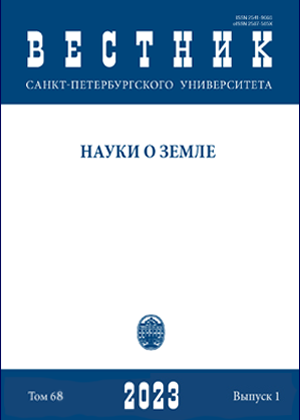Spatial transformation of the migration system during the crisis
DOI:
https://doi.org/10.21638/spbu07.2023.102Abstract
The article devotes to identify the features of the functioning of migration systems in crisis periods characterized by extensive increase of forced migrants' flows. The events of the European migration crisis are analyzed in the case of “Arab countries of Asia - The European Union” migration system. The transformation of the migration system is considered within the framework of geographical variant of the traditional three–stage model of migration process proposed by the authors. The first stage are explored the movements within the region of migration flows formations are explored, the second – the movements between the regions of the formation and accumulation of migration flows within transit regions, the third – the movements within the region of the accumulation of migration flows. Quick increase the number of forced migrants leads to changes in their flow characteristics at each stage, as well as to the expansion of the space of the migration system – compared with that in non-crisis periods. At the same time, there is a complication of the system's structure due to the formation of not only primary and secondary transit regions, but also mono- and poly-branched migration routes within their limits. The findings of the Modified Fractionalization Index (MFI) indicate about a significant decrease in the degree of diversification of migration routes during crisis periods. The result of the distribution of migrants within the region of accumulation is an increase of their territorial concentration. The policy of the European authorities to equalize territorial disparities in the resettlement of migrants has had almost no success. A further increase in the concentration of migrants in the largest urban agglomerations resulting from self-organized movements leads to an aggravation of the ethnic and confessional exclusion of the migrant population.
Keywords:
migration crisis, migration system, refugees, European Union, Arab countries of Asia
Downloads
References
Абрамова, И. О. (2015). Африканская трансграничная миграция и проблемы международной безопасности. Ученые записки Института Африки РАН, 2 (33), 127-136.
Агафошин, М. М. (2020). Миграционный фактор трансформации политического ландшафта в странах Евросоюза. Геополитика и экогеодинамика регионов, 6 (3), 116-125. http://doi.org/10.37279/2309-7663-2020-6-3-116-125
Андреева, Л. А. (2019). Исламизация Германии: «параллельное» мусульманское общество и светское государство. Современная Европа, 5 (91), 110-122. http://doi.org/10.15211/soveurope52019110121
Андреева, Л. А., Следзевский, И. В., Смирнов, М. Ю., под ред. (2021). Трансформации глобального конфессионального геопространства: феномен «параллельных» обществ в системе международно-политических отношений (2021). СПб.: Владимир Даль.
Волков, А. М. (2018). Мигранты в странах Северной Европы: шведский подход. Вестник Института экономики Российской академии наук, 4, 104-119.
Горохов, С. А. (2014). Религиозная мозаичность как фактор экономического развития регионов современного мира. Вестник Московского университета. Серия 5. География, 4, 56-61.
Горохов, С. А., Агафошин, М. М., Дмитриев, Р. В. (2020). Сомалийцы в Швеции: региональное измерение. Современная Европа, 7 (100), 132-143. http://doi.org/10.15211/soveurope72020150161
Долгов, Б. В. (2016). «Исламское государство»*: причины возникновения и перспективы. Азия и Африка сегодня, 6, 2-10.
Ивахнюк, И. В. (2008). Формирование и функционирование Евразийской миграционной системы. Автореферат дис.. д-ра экон. наук.
Казьмина, О. Е. (2017). Государство, школа и церковь: объединение усилий в адаптации и интеграции беженцев и иммигрантов в США. Вестник Московского университета. Серия 21. Управление (государство и общество), 2, 3-22.
Кудеярова, Н. Ю. и Розенталь, Д. М. (2020). Венесуэльский миграционный кризис: демография, нефть и государство. Латинская Америка, 6, 42-56. http://doi.org/10.31857/S0044748X0009592-0
Малахов, В. С. и Касцян, К. А. (2020). Евросоюз перед лицом вынужденной миграции: политическое и юридическое измерение. Полис. Политические исследования, 4, 139-151. https://doi.org/10.17976/jpps/2020.04.10
Осипов, Г. В., Рязанцев, С. В., Храмова, М. Н., Гаджимурадова Г. И. (2016). Миграционный кризис и формирование мусульманских общин в Европе: тенденции и последствия. М.: ФГБУН РАН.
Потемкина, О. Ю. (2015). Миграционный кризис в ЕС: роль стран Вишеградской группы. Современная Европа, 6, 36-45. http://dx.doi.org/10.15211/soveurope620153645
Потемкина, О. Ю. (2016). Миграционный кризис и политика Европейского союза. Актуальные проблемы Европы, 4, 38-60.
Русаков, В. М. и Русакова, О. Ф. (2019). No-Go-Zone и проблемы суверенитета западноевропейских государств. Свободная мысль, 5 (1677), 115-128.
Рыбаковский, Л. Л. (1973). Региональный анализ миграций. М.: Статистика.
Савоскул, М. С. (2015). Территориальные системы международных миграций населения. Вестник Московского университета. Серия 5. География, 6, 11-18.
Толмачева, А. Ю. (2019). Мигранты-мусульмане в Германии: проблемы адаптации и интеграции. Социологическая наука и социальная практика, 3 (27), 57-71. https://doi.org/10.19181/snsp.2019.7.3.6689
Agafoshin, M. M. and Gorokhov, S. A. (2020). Impact of external migration on changes in the Swedish religious landscape. Baltic Region, 12 (2), 84-99. https://doi.org/10.5922/2078-8555-2020-2-6
Buonanno, L. (2017). The European Migration Crisis. In: D. Dinan, N. Nugent, W. E. Patterson, еds, The European Union in Crisis. London: Palgrave Macmillan, 100-130. https://doi.org/10.1057/978-1-137-60427-9_6
Fawcett, J. T. and Arnold, F. (1987). Explanating Diversity: Asia and Pacific Immigration Systems. In: J. T. Fawcett, B. V. Carino, eds, Pacific Bridges: The New Immigration from Asia and the Pacific Islands. New York: Center for Migration Studies, 453-473.
Mabogunje, A. L. (1970). System approach to a Theory of Rural-Urban Migration. Geographical analysis, 2 (1), 1-18. https://doi.org/10.1111/j.1538-4632.1970.tb00140.x
Massey, D. S., Arango, J., Hugo, G., Kouaouci, A., Pellegrino, A., Taylor, J. E. (1998). Worlds in Motion: Understanding International Migration at the End of the Millennium. Oxford: Oxford University Press.
Portes, A. and Borocz, J. (1989). Contemporary Immigration: Theoretical Perspectives on its Determinants and Models of Incorporation.International Migration Review, 23 (3), 606-630.
Downloads
Published
How to Cite
Issue
Section
License
Articles of "Vestnik of Saint Petersburg University. Earth Sciences" are open access distributed under the terms of the License Agreement with Saint Petersburg State University, which permits to the authors unrestricted distribution and self-archiving free of charge.






